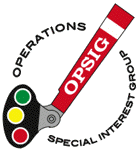Layout Photos
Dispatching the Eastern Illinois Santa Fe
When I was designing and building the Eastern Illinois Santa Fe, I was working from the premise that this railroad would run like the railroad that my friends and I rail fan. It would run the kinds of trains that we saw along the railroad and we would run it in as realistic manner as possible. This meant keeping track of the trains, locomotives, and rolling stock that we saw and also the kind of frequency that we experienced. I have been fortunate through my membership in the Santa Fe Railway Historical and Modeling Society to meet real life railroaders and people who worked on the railroad and in management on the Santa Fe. Their stories and willingness to answer questions on railroad operation has been very helpful. Also paper resources such as Santa Fe track plans or CLIC books (Car Load Inventory Control) have been helpful in recreating the sidings and crossovers on the railroad found in this stretch of the railroad from Joliet to Streator, Illinois.
When working on my NMRA Chief Dispatcher Achievement Certificate I developed a schedule of trains to run on the railroad. This chart shows East Bound and West Bound departures with approximate times of departure and shows where they are expected to meet. With a double track main this might seem a piece of cake to start with, but as soon as a local or 2 locals are out on the railroad using their authorized location on the main, that section of the railroad becomes a one track main and with that, the Dispatcher's role becomes more important, critical and challenging. And I might add, more fun. I find few things more satisfying than having 4 trains on the layout and with a plan to keep them all on the move. Sometimes they may have to spend some time waiting but then it is all part of the experience.
This is a list of the train line ups that I was using 5 years ago. I'll try and find a new one as we have as many as 22 trains to run in a session now. This mainly shows the order that trains will run and how they are lined up in staging. The Macros required to bring them out of staging are indicated along with the Macros needed to run them back into staging.

Here is the schedule that shows when trains are going to be entering the section of the railroad depicted on the layout. The greatest feature for the dispatcher to utilize is the anticipated meets and their locations. You can see that the local trains shown with the yellow lines take the longest amount of time to cross the railroad. Amtrak and Inter-modal trains take the least amount of time to travel through the 50 some mile section of the railroad

This is what the Dispatcher screen looks like. I have added information with the arrows to explain what the dispatcher sees on the screen. This view also shows the aspect of the signals ahead of the train and behind the train. Detection on the layout turns the occupied blocks red on the dispatcher screen and the signals show their proper aspects. Information about signaling on the layout can be seen by clicking here.

This next image shows another view of the dispatcher panel and in this view you can see an Eastbound train that will be crossing from the south main to the north main. The dispatcher manipulates the crossovers by clicking on the crossover and the JMRI signaling software manages the signals on all blocks that are affected by both the occupancy of the blocks and the crossover alignments.

The dispatcher uses Macros or Routes to manage the alignment of the staging tracks that lead to the layout. The NCE DCC system calls this function a Macro. The JMRI name for this function is a Route. They are the same thing but they need to be entered separately with each system. The table of Routes on the left of the image below uses both the Route and Macro naming functions. The heading above the words "Set" is Routes but the User Name is called Macro plus its number. When the Dispatcher selects or sets the Route all the turnouts for the tracks shown in the staging screen line up for that Route/Macro. In the screen seen below the Route/Macro #231 has been selected which means that a train on track 1 will leave staging and proceed on the the South Main going East. You can also see that a Route/Macro had previously been selected for a westbound train to come from the North Main to go to track #5. This track holds 3 trains.

I have quite a few Routes/Macros on the layout and to keep track of them I developed a file in Excel to list the Routes/Macros and indicate the turnouts for each Route/Macro along with the required alignment for that Route/Macro. Having the Routes/Macro table in the Excel spreadsheet was helpful to set up and test the Routes/Macros and also important in case I needed to redo them if there was a computer accident or issue. You can click here to see the Excel spreadsheet The alternating colors are there to make it easier to follow the rows across the page. I chose different colors to show different sections of staging such as one color for East-bounds and another for West-bounds. Other colors were for small staging areas or the locomotive storage area. The Routes/Macro table was created prior to JMRI so I was using the NCE terminology for turnouts/accessories which was "Normal," and "Reversed."







